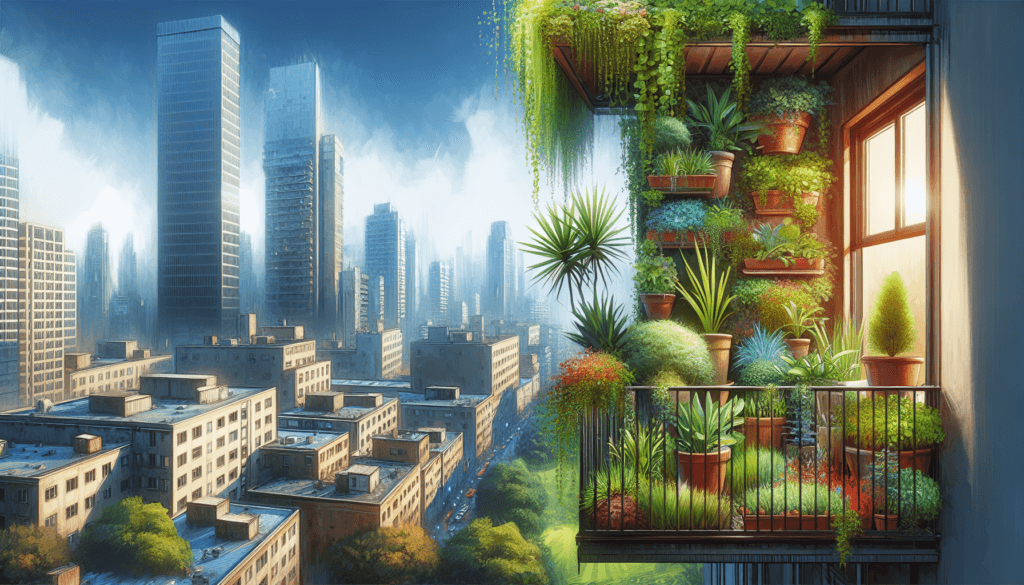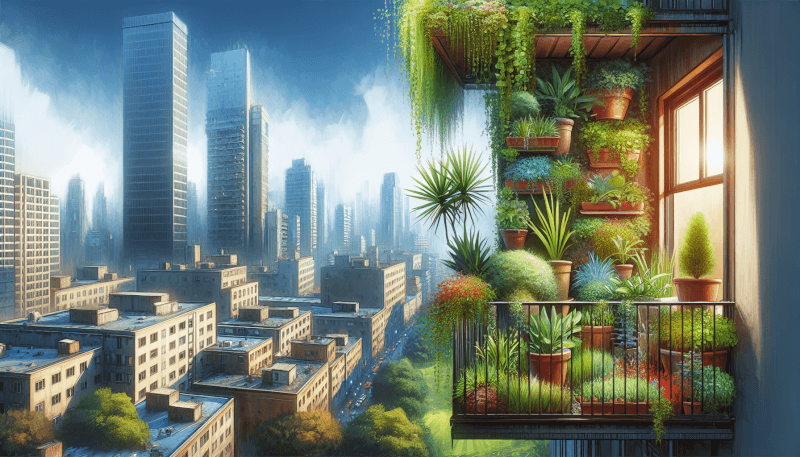Imagine having a beautiful garden right in the heart of the city, where you can escape the hustle and bustle of daily life. Whether you’re an urban dweller with limited time or a green thumb enthusiast seeking a less demanding gardening experience, creating a low-maintenance urban garden is the perfect solution. In this article, discover practical tips and strategies to transform your outdoor space into a tranquil oasis that requires minimal effort and time, allowing you to fully enjoy the benefits of nature without the added stress.

Choosing the Right Plants
Selecting plants that thrive in urban environments
When choosing plants for your urban garden, it’s important to consider the unique challenges that come with gardening in a city. Urban environments often have limited space, high pollution levels, and varying levels of sunlight exposure due to tall buildings and shade from neighboring structures. To ensure the success of your garden, opt for plants that are well-suited to these conditions and have the ability to thrive in urban environments.
Considering the climate and sunlight exposure
One of the most important factors to consider when choosing plants for your urban garden is the climate of your area. Different plants have different temperature and humidity requirements, so it’s essential to select species that are adapted to your local climate. Additionally, pay attention to the sunlight exposure in your garden. Some plants require full sun, while others prefer shaded or partially shaded areas. By understanding these requirements, you can choose plants that will flourish in your urban garden.
Opting for native and drought-resistant species
Choosing native plant species for your urban garden is a great way to support local biodiversity and ensure that your plants are well-adapted to the local climate and soil conditions. Native plants are often more resistant to pests and diseases, making them easier to maintain. Additionally, consider opting for drought-resistant species that can tolerate dry conditions. These plants require less water and are more likely to thrive in urban environments with limited water resources.
Researching plant care requirements
To create a low-maintenance urban garden, it’s essential to research the care requirements of the plants you choose. Each plant has unique watering, fertilizing, and pruning needs that must be met for it to thrive. By understanding these requirements upfront, you can ensure that you provide the proper care without wasting time and energy on unnecessary tasks. Take the time to research and learn about the specific needs of the plants you select to set yourself up for success in maintaining a low-maintenance urban garden.
Designing an Efficient Layout
Planning for limited space
In urban environments, space is often limited, so efficient layout planning is crucial for creating a low-maintenance garden. Evaluate the available space in your garden and maximize its potential by utilizing vertical gardening techniques. Vertical gardens allow you to grow plants vertically, utilizing walls, trellises, or hanging baskets to make the most of the vertical space. This not only saves space but also adds visual interest to your garden.
Utilizing vertical gardening techniques
Vertical gardening is an excellent way to maximize space in your urban garden. Consider growing climbing plants such as ivy or grapevines on trellises or using hanging baskets to grow trailing plants. You can also install wall-mounted planters or utilize vertical hydroponic systems for growing herbs, vegetables, or ornamental plants. By utilizing vertical space, you can create a lush and vibrant garden even in limited areas.
Creating raised beds and containers
Another effective technique for designing an efficient layout in an urban garden is to create raised beds and containers. Raised beds allow you to control the soil quality and drainage, making it easier to maintain healthy plants. Additionally, they help to reduce weed growth and make gardening tasks more accessible by avoiding the need to bend down. Containers, such as pots or troughs, are a great way to grow plants in small spaces like balconies or patios. They are portable, versatile, and allow for easy rearrangement of plants.
Incorporating multi-functional elements
Urban gardens often serve multiple purposes beyond just growing plants. Consider incorporating multi-functional elements into your garden design to make the most out of the available space. For example, you can use trellises or fences as both a support structure for climbing plants and a privacy screen. You can also create seating areas or outdoor lounges that allow you to relax and enjoy your garden while maximizing the functionality of the space. By incorporating multi-functional elements, your urban garden will be both practical and aesthetically pleasing.

Implementing Smart Irrigation Systems
Installing drip irrigation for efficient watering
One of the key elements of a low-maintenance urban garden is efficient watering. Installing a drip irrigation system can help you achieve this goal. Drip irrigation delivers water directly to the base of plants, minimizing water waste and reducing the risk of overwatering. This system also helps to prevent soil erosion and weed growth, making it a smart choice for urban gardeners.
Using rainwater harvesting techniques
Water conservation is particularly important in urban environments where water resources may be limited. Incorporate rainwater harvesting techniques into your garden to make the most of this natural resource. Collect rainwater in barrels or collect it directly from downspouts, and use it to water your plants during dry periods. This not only helps reduce your reliance on municipal water sources but also reduces your water bill.
Automating irrigation with timers or sensors
To make your watering routine even more efficient, consider automating your irrigation system using timers or sensors. Timers can be set to water your plants at specific times, ensuring consistent and appropriate moisture levels. Sensors, on the other hand, can detect soil moisture levels and trigger the irrigation system only when necessary, saving water and reducing the risk of overwatering. By automating your irrigation, you can free up time and reduce the maintenance requirements of your urban garden.
Utilizing self-watering containers
If you’re looking for a low-maintenance watering solution for container plants, consider utilizing self-watering containers. These containers have built-in reservoirs that provide a constant supply of water to the plant’s roots. Self-watering containers can help prevent overwatering and provide a consistent water supply to your plants, reducing the need for frequent watering. This is especially beneficial if you travel often or have a busy schedule that makes consistent watering difficult.
Applying Mulch and Weed Control
Utilizing organic mulch for moisture retention
Mulching is a simple yet effective practice for maintaining a low-maintenance urban garden. Organic mulch, such as wood chips, straw, or compost, helps retain moisture in the soil, reducing the need for frequent watering. Mulch also acts as an insulator, protecting plant roots from extreme temperatures and preventing weed growth. By applying a layer of organic mulch around your plants, you can conserve water, regulate soil temperature, and decrease the time spent on watering and weeding.
Preventing weed growth with mulch or landscape fabric
Weeds can quickly become a nuisance in any garden, especially in urban environments where space is limited and weeds can easily take over. To minimize weed growth and reduce maintenance efforts, use mulch or landscape fabric as a weed barrier. Before applying mulch, lay down a layer of landscape fabric to prevent weed seeds from germinating and growing. This will help keep your garden beds neat and weed-free, saving you time and effort in the long run.
Regularly inspecting and manually removing weeds
While mulch and landscape fabric can significantly reduce weed growth, it’s essential to regularly inspect your garden and manually remove any weeds that do manage to sprout. Regularly inspecting and addressing weed growth prevents them from spreading and competing with your desired plants for resources. By staying proactive and removing weeds as soon as you spot them, you can maintain a low-maintenance urban garden that is free from invasive plants.
Avoiding chemical weed killers and pesticides
In line with creating a low-maintenance and environmentally friendly garden, it’s best to avoid using chemical weed killers and pesticides. These products can harm beneficial insects, pollinators, and the overall ecosystem of your garden. Instead, focus on preventive measures such as mulching and manual weed removal. If necessary, consider using organic weed control sprays or homemade remedies to address persistent weed problems. By avoiding harsh chemicals, you can create a healthier and more sustainable urban garden.

Implementing Low-Maintenance Soil Practices
Amending soil with organic matter for better water retention
Healthy soil is the foundation of a successful urban garden. To create low-maintenance soil, amend it with organic matter such as compost or well-rotted manure. Organic matter improves soil structure, allowing for better water retention and drainage. This helps to reduce the frequency of watering and prevents soil compaction, making it easier for plant roots to access nutrients. By focusing on soil health, you can create a thriving urban garden with minimal maintenance requirements.
Using slow-release fertilizers to minimize feeding frequency
Proper nutrition is vital for the growth and overall health of your plants. To minimize the frequency of feeding, utilize slow-release fertilizers. These fertilizers gradually release nutrients over time, providing a consistent supply to your plants. Slow-release fertilizers are especially useful in urban gardens, where the limited space may not allow for frequent fertilization. By using slow-release fertilizers, you can ensure your plants receive the nutrients they need without the need for regular applications.
Testing soil pH and fertility periodically
Maintaining the optimal pH and fertility levels in your soil is essential for healthy plant growth. Periodically testing your soil using soil testing kits or sending samples to a laboratory can help you identify any imbalances or deficiencies. This information allows you to make informed decisions about the types and quantities of soil amendments, fertilizers, or minerals needed to optimize soil conditions. By monitoring and addressing soil conditions, you can prevent potential plant health issues and reduce the need for frequent soil maintenance.
Practicing proper soil aeration and drainage
Proper soil aeration and drainage are crucial factors in maintaining healthy plant growth. In urban environments, compacted or poorly drained soil is common due to heavy foot traffic and construction activities. To improve soil aeration and drainage, regularly aerate your soil using a garden fork or aerating tool. This breaks up compacted soil, improves water infiltration, and allows plant roots to access oxygen more easily. By maintaining proper soil conditions, you can create an urban garden with healthy plants that require less maintenance.
Choosing Low-Maintenance Garden Structures
Opting for durable and weather-resistant materials
When selecting garden structures, prioritize durability and weather resistance. Urban environments can be harsh on garden structures due to pollution, extreme temperatures, and exposure to wind and rain. Opt for materials such as aluminum, stone, or treated wood that can withstand these conditions and require minimal maintenance. By choosing sturdy and long-lasting garden structures, you can save time and effort on repairs and replacements.
Installing low-maintenance pathways and paving
Pathways and paving play a crucial role in both the functionality and aesthetics of your urban garden. To reduce maintenance efforts, opt for low-maintenance materials such as gravel, decomposed granite, or concrete pavers. These materials require minimal upkeep and can withstand heavy foot traffic. Additionally, ensure proper drainage by designing pathways that allow water to flow away from your garden beds, preventing soil erosion and excess moisture accumulation.
Adding seating areas and relaxing spaces
Urban gardens can serve as peaceful retreats from the hustle and bustle of city life. Incorporate seating areas and relaxing spaces into your garden design to make the most of your outdoor oasis. Choose low-maintenance materials for seating such as durable outdoor furniture made from aluminum or synthetic wicker. Consider incorporating shade structures or pergolas to provide relief from the sun and create a tranquil atmosphere. By creating inviting spaces, you’ll be more likely to spend time in your garden and enjoy the fruits of your labor.
Using minimalistic and functional garden structures
When designing your urban garden, aim for a minimalistic and functional approach to garden structures. Simplify the design by avoiding excessive ornamentation or intricate features that require regular maintenance. Instead, focus on structures that serve a purpose, such as trellises for climbing plants or sturdy arbors for creating shade. By adopting a minimalistic approach to garden structures, you’ll keep your maintenance tasks to a minimum while still achieving an aesthetically pleasing outdoor space.

Implementing Natural Pest Control Methods
Attracting beneficial insects for natural pest control
One effective and environmentally friendly way to control pests in your urban garden is by attracting beneficial insects. Many beneficial insects, such as ladybugs, lacewings, and parasitic wasps, feed on common garden pests like aphids, mites, and caterpillars. To attract these beneficial insects, plant flowers that provide nectar, pollen, and shelter. Examples include marigolds, daisies, and lavender. By supporting a diverse ecosystem of beneficial insects, you can naturally control pests in your garden and reduce the need for chemical insecticides.
Planting companion plants to repel pests
Companion planting is a traditional gardening practice that involves planting certain plants together to benefit each other. Some plants have natural pest-repelling properties and can help protect nearby plants from insect attacks. For example, planting marigolds around vegetable plants can repel nematodes, while planting mint can deter aphids. Research companion planting combinations that work well in your region and incorporate them into your urban garden. By strategically planting companion plants, you can enhance the natural pest resistance of your garden.
Using organic pest control sprays
If pest problems persist despite your efforts to attract beneficial insects and repel pests with companion planting, organic pest control sprays can be used as a last resort. Organic sprays made from ingredients like neem oil, garlic, or soap can effectively control common garden pests without harming beneficial insects or the environment. It’s important to follow the instructions on the spray bottle and apply the sprays when pests are present. Regular monitoring of your garden can help identify any potential pest issues early on, allowing for proactive pest control measures.
Encouraging ecosystem diversity to control pests
Maintaining a diverse ecosystem in your urban garden is key to natural pest control. By including a variety of plants, you can attract a range of insects and wildlife that help control pests. Additionally, providing habitats like birdhouses, bee hotels, or bat boxes can encourage natural predators to visit your garden. This ecosystem diversity creates a balanced environment where pests are naturally controlled and reduces the need for intervention. Embrace the intricacies of nature and let it work in your favor to maintain a low-maintenance urban garden.
Creating a Low-Maintenance Garden Maintenance Routine
Developing a regular watering schedule
Consistency is key in maintaining a low-maintenance urban garden. Develop a regular watering schedule based on the specific needs of your plants and the prevalent weather conditions. Stick to this schedule to ensure your plants receive adequate water without overdoing it. By establishing a routine, you’ll be able to optimize water usage, reduce the risk of underwatering or overwatering, and minimize the time spent on watering tasks.
Pruning and trimming plants as needed
To maintain the health and appearance of your plants, proper pruning and trimming are essential. Regularly inspect your plants for dead or damaged branches and remove them accordingly. Additionally, prune back overgrown plants to maintain their desired shape and prevent them from encroaching on other plants or structures. By taking the time for light pruning and trimming, you can keep your urban garden looking tidy and prevent potential pest or disease issues.
Cleaning and maintaining garden structures
Preventative maintenance of garden structures is essential to ensure they remain functional and aesthetically pleasing. Regularly clean and inspect structures such as trellises, fences, or seating areas to remove dirt, debris, and any potential hazards. Repair or replace any damaged parts to maintain the structural integrity. By staying on top of maintenance tasks, you can prevent larger issues from arising and ensure that your garden structures last for years to come.
Regularly monitoring plant health and addressing issues
Frequent monitoring of plant health is crucial in maintaining a low-maintenance urban garden. Regularly inspect your plants for signs of pests, diseases, or nutrient deficiencies. Address any issues promptly to prevent them from spreading or worsening. This proactive approach allows you to take action early on and reduces the need for intensive and time-consuming interventions later. By staying vigilant and attentive to your plants’ needs, you can maintain a healthy and thriving urban garden with minimal effort.

Utilizing Technology and Automation
Using smart gardening apps for plant care reminders
In the digital age, technology can be a valuable tool in maintaining a low-maintenance urban garden. There are various smart gardening apps available that can provide plant care reminders, tips, and personalized advice based on your specific garden and plants. These apps can help you keep track of watering schedules, fertilizing dates, and pruning tasks, ensuring you stay organized and on top of your plant care routine.
Employing automated irrigation and lighting systems
Take advantage of automated irrigation and lighting systems to make your urban garden more efficient and low-maintenance. Install timers or sensors that control your irrigation system based on predetermined schedules or soil moisture levels. This eliminates the need for manual watering and ensures your plants receive the right amount of water at the right time. Similarly, use automated lighting systems with timers or sensors to provide optimal light levels for your plants, especially in indoor or shaded areas. By harnessing technology, you can simplify your garden maintenance routine and create a more sustainable and intelligent urban garden.
Implementing smart sensors for data monitoring
Smart sensors are an excellent tool for monitoring and optimizing various aspects of your urban garden. Soil moisture sensors can provide real-time feedback on soil moisture levels, allowing you to avoid overwatering or underwatering. Light sensors can help determine the ideal positioning and duration of exposure to sunlight for your plants. By utilizing smart sensors, you can collect data and gain insights into your garden’s specific needs, enabling you to make informed decisions and ensure efficient resource usage.
Utilizing mobile-controlled garden devices
Mobile-controlled garden devices offer convenience and flexibility in maintaining your urban garden. From smart sprinkler controllers to robotic lawn mowers, these devices allow you to monitor and control essential garden tasks with just a few taps on your mobile device. You can adjust irrigation schedules, monitor soil conditions, and even mow your lawn remotely. By utilizing mobile-controlled garden devices, you can save time and effort while still maintaining a well-cared-for urban garden.
Engaging in Community Gardening
Joining or starting a community garden
Community gardening is a wonderful opportunity to connect with like-minded individuals, share resources, and learn from experienced gardeners. Joining an existing community garden allows you to access shared amenities, such as tools, compost, or greenhouse facilities, and learn from the collective knowledge of the community. If there is no community garden in your area, consider starting one yourself. By creating a shared space for gardening enthusiasts, you can foster a sense of community, enhance your gardening skills, and collectively maintain a low-maintenance urban garden.
Sharing resources and knowledge with fellow gardeners
In a community garden setting, the exchange of resources and knowledge is invaluable. Share surplus seeds, seedlings, or produce with fellow gardeners to ensure that resources are utilized efficiently and nothing goes to waste. Additionally, engage in conversations with other gardeners, ask for advice, and share your own experiences. By fostering a spirit of collaboration and learning, you can collectively maintain low-maintenance gardens and support each other’s gardening journeys.
Organizing garden maintenance workshops
Organizing garden maintenance workshops in your community garden can be a fun and educational way to learn and share gardening techniques. These workshops can cover topics such as composting, organic pest control, or container gardening. Each member can contribute their knowledge and expertise, creating a collaborative environment that benefits everyone. By investing time and effort into organizing workshops, you can empower fellow gardeners to maintain their urban gardens with ease.
Participating in local gardening events and initiatives
Participating in local gardening events and initiatives is an excellent way to expand your knowledge, connect with fellow gardeners, and contribute to your community. Look for gardening conferences, workshops, or seed exchanges happening in your area. Get involved in local initiatives focused on sustainable gardening practices or community greening projects. By actively participating in these events and initiatives, you can stay inspired, learn new techniques, and be a part of the larger urban gardening community.
In conclusion, creating a low-maintenance urban garden requires careful consideration of plant selection, efficient design, smart irrigation systems, mulch and weed control, low-maintenance soil practices, durable garden structures, natural pest control methods, a consistent maintenance routine, technological tools, and community engagement. By implementing these strategies, you can create a thriving urban garden that not only enhances your living space but also reduces maintenance efforts and promotes environmental sustainability. Enjoy the process of creating and maintaining your low-maintenance urban garden and reap the rewards of a beautiful green oasis in the heart of the city.


